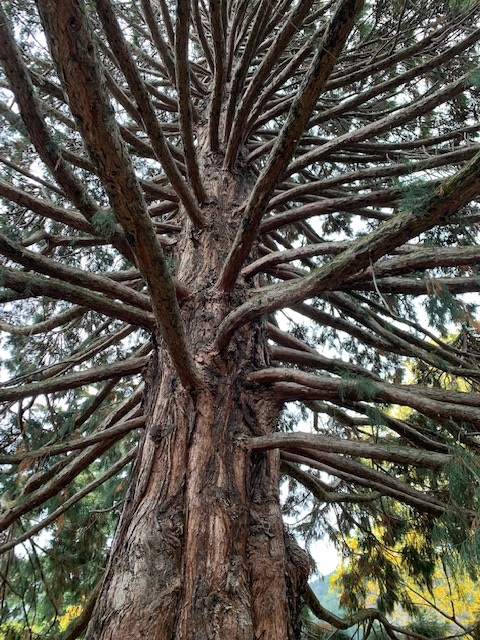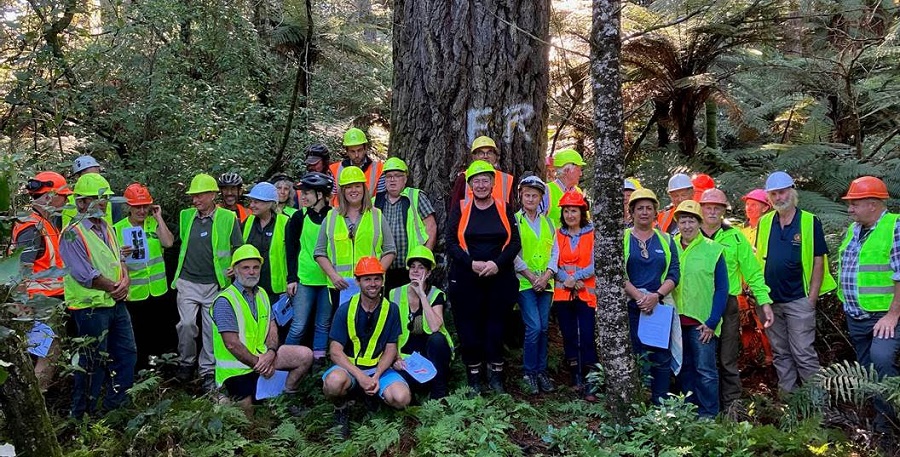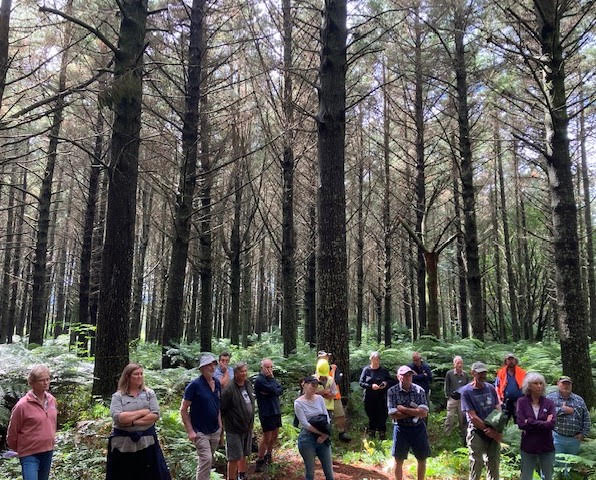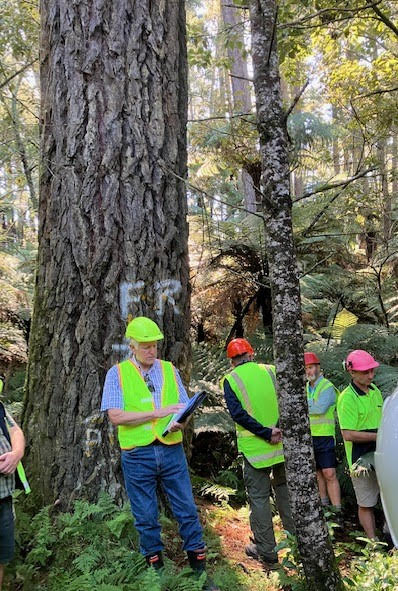Newsletter 145, April 2023

In this issue

Sequoiadendron giganteum Wellingtonia - Queenstown Botanical Gardens
President's Update from Neil Cullen
At our recent conference in Timaru I was elected as your President. This is my second term in this role and already I can see that the demands and expectations have increased markedly since 2019.
Fortunately Graham West and the other office bearers are committed to spreading the load by filling some of the responsibilities the President has previously shouldered alone.
For those who do not know me I farmed in South Otago for more than 40 years and became increasingly addicted to planting and managing trees as part of our farming operation. With the next generation running the farm I have now more time to concentrate on forestry and all the issues that our organisation must deal with.
Over the several decades that I have been a member I don't believe there has been a greater need than now for a strong Farm Forestry Association promoting the wise use of trees on farms and supporting the small scale forest owners.
Cheers Neil.
NZFFA President
Offshoots
-
Hannah believes more women should work in forestry Hannah Allen of Dannevirke believes a lot more women should be working in forestry because they have the attributes that make a good forester.
-
Indigenous Forestry Researcher Farewelled After Nearly 50 Years Of Service Like a mighty totara tree that stands tall and strong, Greg Steward has been celebrated for his resilience, endurance and passion for advancing New Zealand’s knowledge of indigenous forestry over nearly five decades.
Events
For more information on these events, they are posted on the NZFFA website »
Branch secretaries, please make sure you notify head office of any branch or action group events.
- Opportunities with Trees Workshops - NZ Wide April, 2023. The NZ Farm Forestry Association (NZFFA) is running 18 extension workshops in May and June with a target audience of landowners, or people with access to land, who are potential tree…
- North Canterbury Field Day - Little Dale Thursday 27 April 2023 10am Getting to the field day Little Dale is at 403 Heathstock Rd. At the roundabout in central Hawarden, turn westward into Allandale Road. After 6km, 2nd.…
- South Otago Branch Field Day - Campbell Farm Friday 28 April 1.30pm Campbell farm, 215 Taumata Road, Clinton. Get there from either Black Bridge Road or Old Lake Road. This will be a revival of the discussion group…
- Royal Society Te Aparangi Wellington Branch and the Royal Society Te Aparangi - Joint Public Lecture Wednesday 3 May 2023 6 - 7pm Royal Society Te Aparangi premises, 11 Turnbull St. Thorndon, Wellington . On Wednesday 3 May at 6.00 pm the Royal Society Te Aparangi Wellington…
Headlines
- Forest Owners say carbon-only forestry should be kept off productive land April, 2023. The Forest Owners Association would like to see production forestry and farming on productive land – rather than this land used for carbon-only forests. It says this should be a…
- Forest Owners back more trees for Tairawhiti April, 2023. The Forest Owners Association has told the Ministerial Inquiry into land use in Tairāwhiti, that the region’s future has to include more trees for land stability. But it appreciates forest…
- Small scale woodlot owners have their say in Tairawhiti Land use Inquiry April, 2023. he outgoing President of the Farm Forestry Association says it has been vital for farm foresters to directly address the Ministerial Inquiry into forestry and other land use in Tairāwhiti.…
- Future forests need to be multifunctional to meet climate change in Tairawhiti March, 2023. The Farm Forestry Association says the just convened Ministerial Inquiry, into land-use across Tairāwhiti, needs to look closely at the tree options for shoring up vulnerable farm and former forest land in…
- Hill country farming campaign shows they think climate change is someone else’s problem March, 2023. The Forest Owners Association says the latest campaign against forestry, led by Beef+Lamb New Zealand and 50 Shades of Green, is climate change responsibility denial, and is dangerous in the…
- Forest Owners says two months too brief to look into the complex land issues in Tairawhiti. February, 2023. The Forest Owners Association says the two month long inquiry into land use in Tairāwhiti doesn’t give enough time or depth to find solutions. The Prime Minister, Chris Hipkins has…
- Forest Owners want genetic technology approved February, 2023. The Forest Owners Organisation says New Zealand needs to concentrate on the safety of genetic technology on a case-by-case basis rather than persisting with blanket bans. The FOA wants approval…
Positive moves within the NZFFA Executive
Vaughan Kearns - Vice President
For a number of years there has been a lack of farmer representation on the NZFFA executive. I am glad to be able to report that following the AGM this has been addressed to a great extent.
We are extremely lucky to have a steady hand at the helm with the election of South Otago farmer, Neil Cullen who was elected President after the retirement of an extremely busy Graham West at the AGM.
Graham has done sterling service for the organisation and has taken us ahead in several areas and will maintain close ties to many of the organisations where he has represented us previously. Neil of course has held the President’s role before. He will notice how the influence of the NZFFA has grown, even in the years since his first appointment.
With a good supportive team around him, we are expecting that he won’t find this position as taxing as has been the case previously.
Further farmer representatives come through the new appointments of North Canterbury sheep and deer man Gary Fleming, who takes the place of Patrick Milne, who has retired, and David Forsythe, ex Waikato dairy farmer from Te Awamutu.
With Bull Beef and Poplar campaigner Tim Forde of Hawkes Bay remaining, this leaves four well rounded men to represent the farming sector from within our organisation.
We have lost a good man with a science background with the departure of Pat Milne, but with new recruit Les Dowling from Rotorua joining us we maintain the good position of two men with science backgrounds, the other being immediate Past President, Graham West.
Neil has appointed sawmill director Vaughan Kearns (the writer) as his Vice President. I intend to take as much load off the boss as I can so that his role can be less onerous than it was during his previous term. This might be a good place to confirm that I have no intention to push for the top job. I believe that it remains in the best interests of the Association, that we continue to have landowners with farming experience leading us.
We have a new Secretary in Hamish Levack and Treasurer in Howard Moore. Hamish and executive member Michael Orchard are the two career foresters within our ranks.
After the Executive meeting held yesterday, April 20th the team reads as follows:
- Patron: Eric Appleton, Nelson
- President: Neil Cullen, South Otago
- Immediate Past President: Graham West, Bay of Plenty
- Vice President: Vaughan Kearns, Middle Districts
- Secretary: Hamish Levack, Wellington
- Treasurer: Howard Moore, Wellington
- Administrator: Liz Chamberlain, Wellington
Executive committee:
- Egon Guttke, Wellington
- Tim Forde, Hawkes Bay
- Dave Forsythe, Waikato
- Gary Fleming, North Canterbury
- Michael Orchard, West Coast
- Dougal Morrison, Kapiti Coast/ Wellington
- Les Dowling, Bay of Plenty
- Laurie Bennett, North Canterbury
- Michael Gravatt, Northland
Timely forestry workshops for farmers wanting to diversify and control erosion
The New Zealand Farm Forestry Association is running 18 extension workshops throughout New Zealand in May and June to target potential tree growers.
National FFA President, Neil Cullen says the timing is ideal of farmers who are interested in diversifying their long-term farm income.
“Trees are not just about the timber potential. They also protect the land and store carbon.”
Neil Cullen says farmer and landowner participants will also learn about the benefits of planting different species to help mitigate climate change, provide shade and shelter, reduce erosion and improve water quality.
“This is particularly timely and important when we note the huge areas of erosion caused by the cyclones in Northland, Tairawhiti and Hawke’s Bay in January and February. That’s why there will be a focus on alternative species to help control erosion.”
Please go to Opportunities from Trees to find out where the workshops are being held and to register.
Neil Cullen and NZFFA appreciate the support from Te Uru Rakau – New Zealand Forest Service to be able to run the workshops.
Worksafe
WorkSafe is Aotearoa New Zealand’s primary workplace health and safety regulator. We lead, enforce, contribute to, and promote improved health and safety at work, and energy safety. Our vision is “ka haere nga tangata katoa ki te mahi, ka hoki hauora, haumaru mai ki te kainga” - everyone who goes to work comes home healthy and safe.
We work across all wahi mahi (workplaces) in Aotearoa, including the farm and forestry sectors.
We support businesses to reduce work related health risks, connect with leaders who can influence and control health and safety risks and take responsibility, and work with workers and organisations to improve how work is designed and delivered for better health and
safety outcomes for all.
Thanks for visiting us at the Farm Forestry conference in Timaru. We look forward to connecting with you in the future.
Carbon Forestry Sinks - Seeing is Believing
Bay of Plenty held a successful Field Day on 18 March 2023. The focus was Carbon Forestry Sinks.

The field day drew to a close at the Kaingaroa old cop stand, established in 1921 and at 100 years old contains 84 trees per hectare that are carrying around 2,000 tonnes of C02e per hectare. Photo credits. Viv Barr.
The day started at Gee Road, Rotorua, surrounded by some of the 500 hectares of radiata pine new land established since 2018 on the three stations owned by Ngati Whakaue Tribal Lands.
The group observed radiata pine established within a birds flight distance of tall timber native forest acts as a nurse crop for the natural seeding of natives by birds as demonstrated at the Horohoro site.

The final crop stocking demonstration planting at Horohoro well illustrates the carbon issued under the lookup tables or measured for forest land registered under the ETS greater than 99 hectares. The lookup tables result in this forest (irrespective of tree stocking per hectare) to be yielding a total of 780 tonnes per hectare. Many/most forests established today under the NZ ETS purposefully establish and carry for as long as possible (before thinning may need to be applied) high tree stockings per hectare that can produce 50-100% more carbon than what is available using the lookup tables. Growers with less than 100 hectares can join together under a single entity to take advantage of the much higher yields of carbon using the field measurement approach.

Graham West presented a high interest study confirming that radiata pine and other species have all been significantly underestimated when using the regional lookup tables. Furthermore study results clearly showed that exotic forests can sequester carbon at greater rates than indicated by the ETS Lookup Tables and do not collapse from old age. Instead, they reduce in stand density with age through the steady attrition of weaker trees, they are likely to continue to add carbon, and remain standing well past 100 years of age. The trend to low stockings allows light into the stand at older ages and aids the transition to indigenous species on the right sites. Graham advised that work was in train to correct the lookup tables.
One of the participants was Jamie Heather from Carbon Critical. His businesses web site contains an interactive dashboard that enables the user to obtain carbon net zero (preferably by 2040). The dashboard is contained here Carbon Critical Net-Zero Challenge
Jeff Tombleson concluded the field day with the comments that all forest types and species contributed to maintaining NZs forest carbon sink. From a national and long term perspective the establishment of radiata pine nurse crops at scale that naturaly transition to natives were the solution to addressing NZs requirement to establish 1.3 million hectares of new forests.
Jeffs final comments were encouragement to farm foresters under the NZ ETS to wring it out for everything it’s worth, and most importantly “make hay while the sun shines”.
|
President: Neil Cullen president@nzffa.org.nz Newsletter editor: Dean Satchell dsatch@gmail.com National Office: Liz Chamberlain admin@nzffa.org.nz |
Members |
| Disclaimer: Personal views expressed in this newsletter are those of the writers and do not necessarily represent those of the NZ Farm Forestry Association. | |
